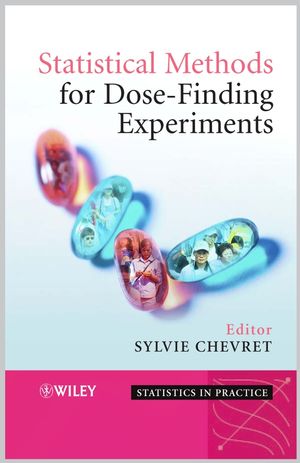Statistical Methods for Dose-Finding ExperimentsISBN: 978-0-470-86123-3
Hardcover
336 pages
May 2006
 This is a Print-on-Demand title. It will be printed specifically to fill your order. Please allow an additional 10-15 days delivery time. The book is not returnable.
|
||||||
Preface.
Introduction (Sylvie Chevret).
Part I. General Principles and Controversial Issues in Dose-Findings.
1. Basic concepts in dose-finding (Sylvie Chevret).
1.1 Main concepts.
1.2 Main issues from a pharmaceutical point of view.
1.3 Statistical issues of dose-finding phase I trials.
1.4 Conclusion.
References.
2. Philosophy and methodology of dose-finding – a regulatory perspective (Robert Hemmings).
2.1 Introduction.
2.2 In search of the optimal dose.
2.3 Regulatory requirements for drug licensure.
2.4 Benefits to the sponsor and the patient of providing data on dose-response over and above those required for licensing.
2.5 Trial designs for determining dose-response.
2.6 Discussion.
References.
Part II. Algorithm-Based Approaches.
3. Traditional and modified algorithm-based designs for phase I cancer clinical trials (Weichung Joe Shih and Yong Lin).
3.1 Introduction.
3.2 Notation and convention.
3.3 Traditional algorithm-based designs.
3.4 Modified algorithm-based designs.
3.5 Probability of a dose being chosen as the MTD.
3.6 Expected number of patients treated at each dose level.
3.7 Other statistical properties.
3.8 Examples.
3.9 Discussion.
Acknowledgments.
References.
4. Accelerated titration designs (Janet Dancey, Boris Freidlin and Larry Rubinstein)
4.1 Introduction.
4.2 Design.
4.3 Evaluation of performance.
4.4 Model-based analysis.
4.5 Clinical applications.
4.6 Conclusions.
References.
5. Group up-and-down designs in toxicity studies (Anna Ivanova and Nancy Flournoy).
5.1 Introduction.
5.2 Group up-and-down designs for phase I clinical trials.
5.3 Designs for acute toxicity studies.
5.4 Fully sequential designs for phase I clinical trials.
5.5 Start-up rules.
5.6 Estimation.
5.7 Up-and-down designs to find the dose with maximum success probability.
5.8 Discussion.
References.
Part III. Model-Based Approaches.
6. The continual reassessment method (Sylvie Chevret and Sarah Zohar).
6.1 Introduction.
6.2 The original continual reassessment method (CRM).
6.3 Likelihood CRM (CRML).
6.4 Modified continual reassessment method (MCRM).
6.5 Concluding remarks.
References.
7. Using Bayesian decision theory in dose-escalation studies (John Whitehead).
7.1 Introduction.
7.2 Example of a dose-escalation study.
7.3 A statistical model for the study.
7.4 Prior information.
7.5 Gain functions.
7.6 Safety constraints and stopping rules.
7.7 Evaluation of the Bayesian approach.
7.8 Discussion.
References.
8. Dose-escalation with overdose control (Mourad Tighiouart and Andr´e Rogatko).
8.1 Introduction.
8.2 Escalation with overdose control design.
8.3 Adjusting for covariates.
8.4 Choice of prior distributions.
8.5 Concluding remarks.
References.
9. Dose-escalation methods for phase I healthy volunteer studies (Y. Zhou).
9.1 Introduction.
9.2 Frequentist analysis.
9.3 A Bayesian analysis.
9.4 Conducting dose-escalation using a Bayesian decision–theoretic approach.
9.5 Multiple simulations.
9.6 Conclusions.
Acknowledgements.
References.
Part IV. Future Trends for Past Issues.
10. Defining stopping rules (Sarah Zohar).
10.1 Introduction.
10.2 Background.
10.3 Dose-finding specificities.
10.4 Examples.
10.5 Conclusions.
Acknowledgment.
References.
11. Dose-finding with delayed binary outcomes in cancer trials (Ying Kuen Cheung).
11.1 Introduction.
11.2 Review of current practice.
11.3 Basic methods.
11.4 An example.
11.5 Simulation results.
11.6 Chronic toxicities.
11.7 Discussion.
11.8 Bibliographic notes.
References.
12. Dose-finding based on multiple ordinal toxicities in phase I oncology trials (B. Nebiyou Bekele and Peter F. Thall).
12.1 Introduction.
12.2 Probability model.
12.3 Dose-finding algorithm.
12.4 Elicitation process.
12.5 Application to the sarcoma trial.
12.6 Simulation study and sensitivity analyses.
12.7 Concluding remarks.
References.
13. A two-stage design for dose-finding with two agents (Peter F. Thall)
13.1 Introduction.
13.2 Dose-toxicity model.
13.3 A two-stage dose-finding algorithm.
13.4 Application.
13.5 Discussion.
References.
14. Using both efficacy and toxicity for dose-finding (Peter F. Thall and John D. Cook).
14.1 Introduction.
14.2 Illustrative trial.
14.3 Dose-outcome models.
14.4 The dose-finding algorithm.
14.5 Simulation studies.
14.6 Discussion.
References.
Part V. Conclusions.
15. Websites and software (Sarah Zohar).
15.1 Introduction.
15.2 Computation methods using statistical software.
15.3 Phase I or phase II dose-finding software.
15.4 Phase I/II dose-finding software.
15.5 Conclusions.
References.
Appendix: random numbers generation.
Index.



